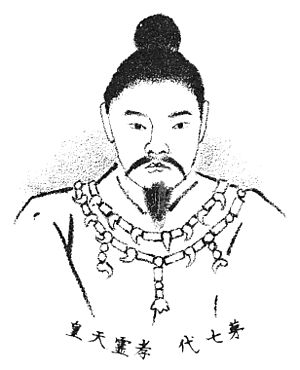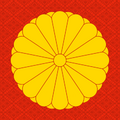Emperor Kōrei facts for kids
Quick facts for kids Kōrei |
|
|---|---|
| Emperor of Japan | |
 |
|
| Reign | legendary |
| Predecessor | Kōan |
| Successor | Kōgen |
| Born | legendary |
| Died | legendary |
| Burial | Kataoka no Umasaka no misasagi (Nara) |
Emperor Kōrei (孝霊天皇, Kōrei-tennō) was the 7th emperor of Japan. This is based on the traditional list of emperors. Many historians believe Emperor Kōrei was a legend. His name, Kōrei-tennō, was given to him after his death by people who lived much later.
We don't have exact dates for when he lived or ruled. The names and order of these early emperors became 'traditional' much later. This happened during the time of Emperor Kammu, who was the 50th ruler of the Yamato dynasty. An old book called the Gukanshō says Kōrei ruled from a palace called Ihoto-no-miya. This palace was in Kuroda, a place that later became known as Yamato Province.
Contents
Who Was Emperor Kōrei?
Most people think Kōrei was a legend. The Kojiki, an ancient Japanese book, only mentions his name and family tree. Another important book, the Nihonshoki, lists Kōrei as the sixth of eight "undocumented monarchs." These are rulers for whom there isn't much historical information.
Kōrei was the oldest son of Emperor Kōan. The Jinnō Shōtōki, another historical text, says his mother was Oshihime. She was the daughter of Ametarashihiko-Kunio-shihito-no-mikoto.
Some experts wonder if the first nine emperors truly existed. These experts believe that Kōrei's great-grandson, Emperor Sujin, was the first emperor who actually lived.
What Happened During Kōrei's Time?
Just because we don't have much information about Kōrei doesn't mean he never existed. There is very little information available for study before the reign of the 29th ruler, Emperor Kimmei.
The Kojiki mentions that Kibi Province was conquered during Kōrei's reign. This would have been an important event for the time.
After His Reign
The official name given to this emperor after his death is called a posthumous name. This name was made official many centuries after Kōrei was said to have lived.
The exact place where he is buried is not known today. However, the Imperial Household Agency says that this emperor is honored at a special Shinto shrine called a misasagi. This memorial shrine is located in Nara.
Images for kids
-
The chrysanthemum symbol of the Japanese emperor and his family.
Related pages
| Preceded by Emperor Kōan |
Legendary Emperor of Japan Kōrei 290-215 BC (traditional dates) |
Succeeded by Emperor Kōgen |
See also
 In Spanish: Kōrei Tennō para niños
In Spanish: Kōrei Tennō para niños


